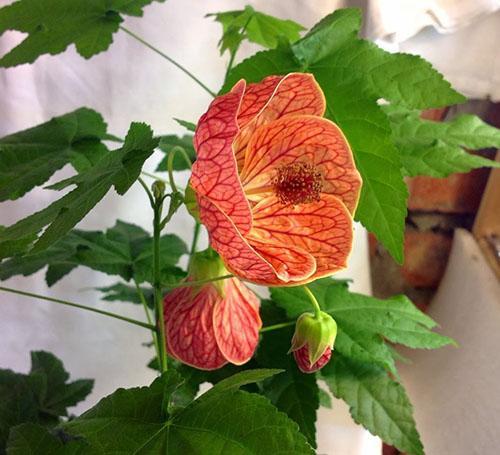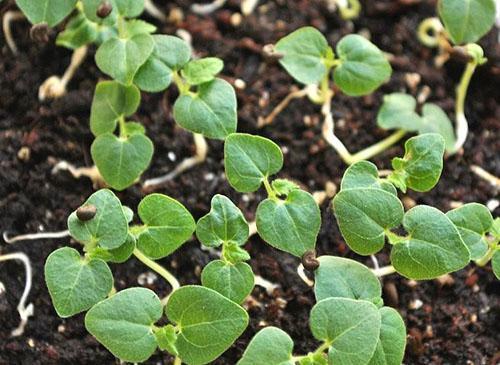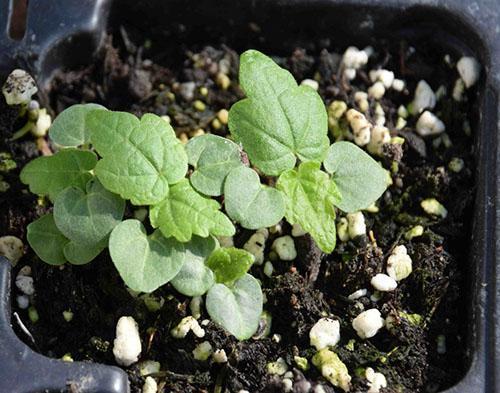Reproduction methods of indoor flower abutilon
 Abutilones with bell-shaped flowers or wide-open hibiscus corollas are becoming more and more popular among indoor plant lovers. And the reason here is not only lush flowering, but also the unpretentiousness of the culture, as well as the ease of its reproduction.
Abutilones with bell-shaped flowers or wide-open hibiscus corollas are becoming more and more popular among indoor plant lovers. And the reason here is not only lush flowering, but also the unpretentiousness of the culture, as well as the ease of its reproduction.
Reproduction of abutilon by seeds

For germination, it is better to take boiled, thawed or settled warm water. Seeds are laid out on top of the wet layer and the container is covered with a lid or film.
The swelling of seeds for the reproduction of abutilon begins within a few hours. It is best to keep the container warm, around 25 ° C. The emergence of roots will become noticeable after 4-8 days. Miniature sprouts are transferred to the ground, but it is not worth delaying the transplant, since the rapidly developing roots are easy to damage. This method is useful if there are doubts about the germination of seeds selected for reproduction of abutilon.
If the seed is well ripened and fresh, it can be sown immediately into a nutritious light substrate, or even better - in peat tablets.
In this case, it is important to avoid excessive burial of the seeds. It is optimal if there is a layer of soil just a couple of millimeters above the seeds. In the substrate, the sprouts receive a full range of nutrients and a sufficient amount of moisture. They quickly acclimatize after picking and soon reach the size of a specimen ready for flowering.
 You can dive seedlings at the stage of two true leaves. With this size, the plants are suitable for pots with a volume of no more than 50-100 ml. And then, as the indoor flower grows, the abutilone is transplanted into larger containers.
You can dive seedlings at the stage of two true leaves. With this size, the plants are suitable for pots with a volume of no more than 50-100 ml. And then, as the indoor flower grows, the abutilone is transplanted into larger containers.
If there is already an adult plant in the house, it can be used to obtain cuttings and propagate the favorite variety of abutilone.
 Although the seeds of this flower germinate well, and it is possible to grow a young, ready-to-bloom specimen within one year, the vegetative method has many advantages:
Although the seeds of this flower germinate well, and it is possible to grow a young, ready-to-bloom specimen within one year, the vegetative method has many advantages:
- When grafting abutilone, you can be sure that the daughter plant will retain all the properties of the mother, including variegated foliage and other characteristics of the hybrids.
- The time from planting to the moment the first flowers appear on Abutilon is significantly reduced.
How to cut abutilone?
 At home, abutilone develops very quickly and during the growing season, which lasts from spring to late autumn, gives young shoots of considerable length. Therefore, in the pot culture, abutilones are necessarily cut, helping the crown to bush and remain compact. In addition, the formation contributes to lush flowering, because the buds appear only on young shoots.
At home, abutilone develops very quickly and during the growing season, which lasts from spring to late autumn, gives young shoots of considerable length. Therefore, in the pot culture, abutilones are necessarily cut, helping the crown to bush and remain compact. In addition, the formation contributes to lush flowering, because the buds appear only on young shoots.
Pruning is carried out in the spring and at the end of summer, when the main wave of abutilon flowering ends. At the same time, not only weak and damaged shoots are removed, but at least a third of the length from strong branches is cut off. The resulting cuttings, which have at least 2-3 internodes, should not be thrown away, because this is the best planting material.
It is enough to free the cuttings of abutilon from the lower tiers of leaves, remaining buds and flowers, and then put them in water and cover the container with a bag. Already after a few days at temperatures above 22 ° C at the end of the stem, you can see the appearance of thickening and the beginnings of thin white roots.
To protect the plant from decay, an activated carbon tablet or a few crushed pieces of charcoal can be dipped into the water.
Rooting between 3 and 7 cm in length means that Abutilone can be transplanted to a permanent location. For a young flower of abutilon, a pot with a diameter of about 7 cm is enough.A powerful drainage is made at the bottom, on top of which a small layer of soil is poured and the seedling is carefully transferred into it.
 Sprinkle the sprout with a moist substrate very carefully, since the roots of abutilone are fragile and can break off. For the same reason, it is better not to compact the soil after transplanting. The rooting and acclimatization of the cuttings of abutilone takes several weeks, as evidenced by the appearance of young leaves. It is good if this time the plant is in a greenhouse or covered with a bag that creates a constant microclimate.
Sprinkle the sprout with a moist substrate very carefully, since the roots of abutilone are fragile and can break off. For the same reason, it is better not to compact the soil after transplanting. The rooting and acclimatization of the cuttings of abutilone takes several weeks, as evidenced by the appearance of young leaves. It is good if this time the plant is in a greenhouse or covered with a bag that creates a constant microclimate.
The temperature for rooting an abutilon flower should not be high. The optimum level is 20–22 ° C.
 In three or four weeks, the rooting of the cuttings takes place, soon after cutting, the planted in a moist substrate of peat and vermiculite. Such plants, after a month in the greenhouse, can also be transplanted into individual pots. As a rule, young seedlings actively bloom after a few months, and after the end of the growing season they can already become a source for the subsequent propagation of abutilone.
In three or four weeks, the rooting of the cuttings takes place, soon after cutting, the planted in a moist substrate of peat and vermiculite. Such plants, after a month in the greenhouse, can also be transplanted into individual pots. As a rule, young seedlings actively bloom after a few months, and after the end of the growing season they can already become a source for the subsequent propagation of abutilone.
Pollination of an abutilon flower and obtaining seeds
 Abutilone can be propagated by seeds obtained by pollination of plants at home. By transferring pollen from one plant variety to another, you can get hybrid seeds with unprecedented properties.
Abutilone can be propagated by seeds obtained by pollination of plants at home. By transferring pollen from one plant variety to another, you can get hybrid seeds with unprecedented properties.
A clean, dry cotton swab or a thin brush can become a tool for such work. It is this method of reproduction of abutilone that breeders use.
And the success of pollination is evidenced by the formation of a multifaceted box in place of the flower, which begins to dry out after about a month, and then opens.
 Sowing is carried out in the already described way, and a video about abutilone and the details of the flower reproduction process will help to avoid annoying mistakes in this interesting business.
Sowing is carried out in the already described way, and a video about abutilone and the details of the flower reproduction process will help to avoid annoying mistakes in this interesting business.